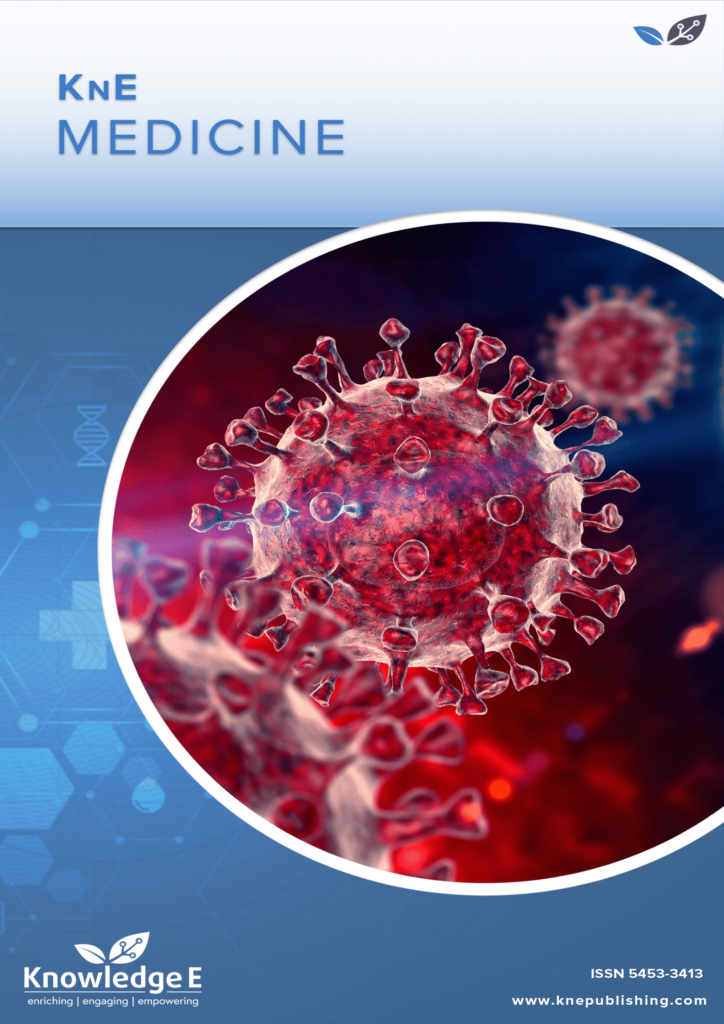
KnE Medicine
ISSN: 2519-125X
The latest conference proceedings on all fields of medicine.
In Vitro Antimicrobial Potential of Impatiens Balsamina Flower Against Staphylococcus Aureus, Escherichia Coli and Candida Albicans
Published date: Sep 15 2022
Journal Title: KnE Medicine
Issue title: The International Conference of Medicine and Health (ICMEDH)
Pages: 405–415
Authors:
Abstract:
The search for new drugs to treat cases of infection continues. This is because the microorganisms that cause infection continue to mutate as a form of self-defense which causes resistance to antibiotics. One strategy for finding new drugs is through the exploration of active ingredients derived from plants that have been used empirically by the community. Impatiens balsamina is a plant that has been shown to have antibacterial, antifungal, antipruritic, and anti-allergic characteristics. The ethanol extract of the Impatiens balsamina flower contains secondary metabolites such as naphthoquinones, coumarin derivatives, flavonoids, steroids, quinones, and saponins. This study aimed to obtain the active ingredient of the Impatiens balsamina flower which is used as an herbal medicine in the treatment of infection. A multilevel extraction process was carried out using solvents of different polarity, so that fractions containing nonpolar compounds, semipolar compounds, and polar compounds were obtained. Then, each fraction was tested for antimicrobial potency. Antimicrobial testing in vitro was carried out using the disc diffusion method. The results showed that the secondary metabolites contained in the hexane fraction were terpenoids, flavonoids, polyphenols, and anthraquinone compounds. Secondary metabolites contained in the ethyl acetate fraction were alkaloids, terpenoids, flavonoids, polyphenols, and anthraquinone compounds. Secondary metabolites contained in the ethanol fraction were terpenoids, flavonoids, polyphenols, and anthraquinone compounds. The hexane fraction had the best percentage of inhibition and percentage of effectiveness against Staphylococcus aureus, Escherichia coli, and Candida albicans.
Keywords: antimicrobial, fractionation, Impatiens balsamina L flower, disc diffusion
References:
[1] (Nurvita) Wikansari, “Pemeriksaan Total Kuman Udara Dan Staphylococcus Aureus Di Ruang Rawat Inap Rumah Sakit X Kota Semarang.,” Jurnal Kesehatan Masyarakat Universitas Diponegoro. vol. 1, no. 2, p. 18795, 2012.
[2] F. Anwari and A. Mega, “Sakit Anwar Medika Sidoarjo.,” pp. 31–38, 2017.
[3] World Health Organisation, Report on the burden of endemic health care-associated infection worldwide: Clean care is safer care., 2011.
[4] Kementrian Kesehatan Republik Indonesia, PEDOMAN PENCEGAHAN DAN PENGENDALIAN INFEKSI DI FASILITAS PELAYANAN KESEHATAN., 2017.
[5] Karen C. Carroll, J.S. Butel, and S.A. Morse, Medical Microbiology. McGraw-Hill Companies, New York, 2015.
[6] R. Endriani, F. Andrini, and D. Alfina, “Pola Resistensi Bakteri Penyebab Infeksi Saluran Kemih (ISK) Terhadap Antibakteri di Pekanbaru.,” Jurnal Natur Indonesia. vol. 12, no. 2, p. 130, 2012.
[7] G.S. Nurjanah, A.I. Cahyadi, and S. Windria, “Kajian Pustaka : Resistensi Escherichia coli Terhadap Berbagai Macam Antibotik pada Hewan dan Manusia.,” Indonesia Medicus Veterinus. vol. 9, no. November, pp. 967–980, 2020.
[8] T. Wulansari, D. Sagita, and S. Pratama, “Uji Resistensi Antibiotik Terhadap Kultur Bakteri Enterobacter agglomerans di Ruang Intensive Care Unit ( ICU ) Rumah Sakit X Kota Jambi Antibiotic Resistance Test Against Enterobacter agglomerans Culture In The Intensive Care Unit ( ICU ) Hospital X Jamb.,” vol. 6, no. 1, pp. 237–248, 2020.
[9] A.S. Fahirah Arsal, “Deteksi dan Pola Kepekaan Antibiotik pada Extended Spectrum Beta Lactamase (Esbl) Eschericia Coli dari Sampel Urin Petugas Kesehatan di Rumah Sakit Ibnu Sina Makassar Tahun 2018.,” UMI Medical Journal. vol. 3, no. 2, pp. 1–13, 2019.
[10] N.E. Thomford, D.A. Senthebane, A. Rowe, et al., “Natural products for drug discovery in the 21st century: Innovations for novel drug discovery.,” International Journal of Molecular Sciences. vol. 19, no. 6, p. 2018.
[11] M. Adfa, “Isolasi Senyawa Flavonoid Aktif Berkhasiat Sitotoksik Dari Daun Kemuning (Murraya Panicullata L. Jack).,” Jurnal Gradien. vol. 3, no. 2, pp. 262–266, 2007.
[12] G.A. Kusuma, S.N.J. Longdong, and R.A. Tumbol, “Uji Daya Hambat Dari Ekstrak Tanaman Pacar Air (Impatiens balsamica L) Terhadap Pertumbuhan Bakteri Aeromonas hydrophila.,” jurnal ilmiah PS. agrobisnis perikanan UNSRAT, Manado. pp. 9–12, 2014.
[13] S.M.A. Budiana, N.S. Kojong, and D.S. Wewengkang, “Uji Aktivitas Antibakteri Ekstrak Etanol Bunga dan Biji Tanaman Pacar Air (Impatiens Balsamina L.) Terhadap Pertumbuhan Bakteri Staphylococcus aureus, Pseudomonas aeruginosa dan Escherichia coli Secara in-Vitro.,” Pharmacon. vol. 4, no. 4, pp. 214–223, 2015.
[14] D.A. Talan, S.S. Takhar, A. Krishnadasan, et al., “Fluoroquinolone-Resistant and Extended-Spectrum β-Lactamase– Producing Escherichia coli Infections in Patients with Pyelonephritis, United States.,” Emerging Infectious Diseases. vol. 22, no. 9, pp. 1594–1603, 2017.
[15] S.Y.C. Tong, J.S. Davis, E. Eichenberger, T.L. Holland, and V.G. Fowler, “Staphylococcus aureus infections: Epidemiology, pathophysiology, clinical manifestations, and management.,” Clinical Microbiology Reviews. vol. 28, no. 3, pp. 603–661, 2015.
[16] Y. Cong, S. Yang, and X. Rao, “Vancomycin resistant Staphylococcus aureus infections: A review of case updating and clinical features.,” Journal of Advanced Research. vol. 21, pp. 169–176, 2020.
[17] S.E. Majowicz, E. Scallan, A. Jones-Bitton, et al., “Global incidence of human shiga toxin-producing escherichia coli infections and deaths: A systematic review and knowledge synthesis.,” Foodborne Pathogens and Disease. vol. 11, no. 6, pp. 447– 455, 2014.
[18] J.E. Ross, N.E. Scangarella-Oman, R.K. Flamm, and R.N. Jones, “Determination of disk diffusion and MIC quality control guidelines for GSK2140944, a novel bacterial type II topoisomerase inhibitor antimicrobial agent.,” Journal of Clinical Microbiology. vol. 52, no. 7, pp. 2629–2632, 2014.
[19] O. Gefen, B. Chekol, J. Strahilevitz, and N.Q. Balaban, “TDtest: Easy detection of bacterial tolerance and persistence in clinical isolates by a modified disk-diffusion assay.,” Scientific Reports. vol. 7, no. February, pp. 1–9, 2017.
[20] M. Balouiri, M. Sadiki, and S.K. Ibnsouda, “Methods for in vitro evaluating antimicrobial activity: A review.,” Journal of Pharmaceutical Analysis. vol. 6, no. 2, pp. 71–79, 2016.
[21] W. van den Bijllaardt, A.G. Buiting, J.W. Mouton, and A.E. Muller, “Shortening. the incubation time for antimicrobial susceptibility testing by disk diffusion for Enterobacteriaceae: How short can it be and are the results accurate?,” International. Journal of Antimicrobial Agents. vol. 49, no. 5, pp. 631–637, 2017.